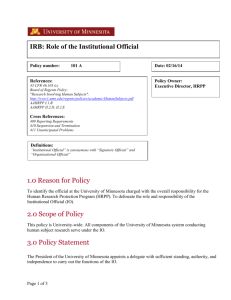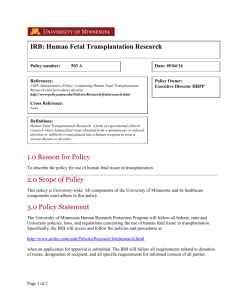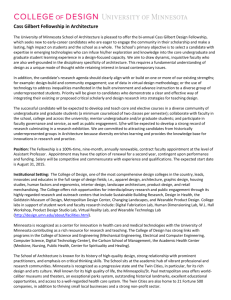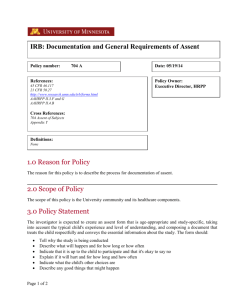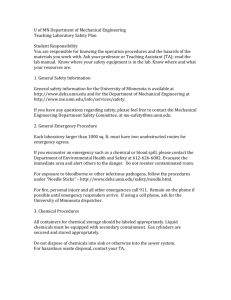HRPP Components - Institutional Review Board
advertisement
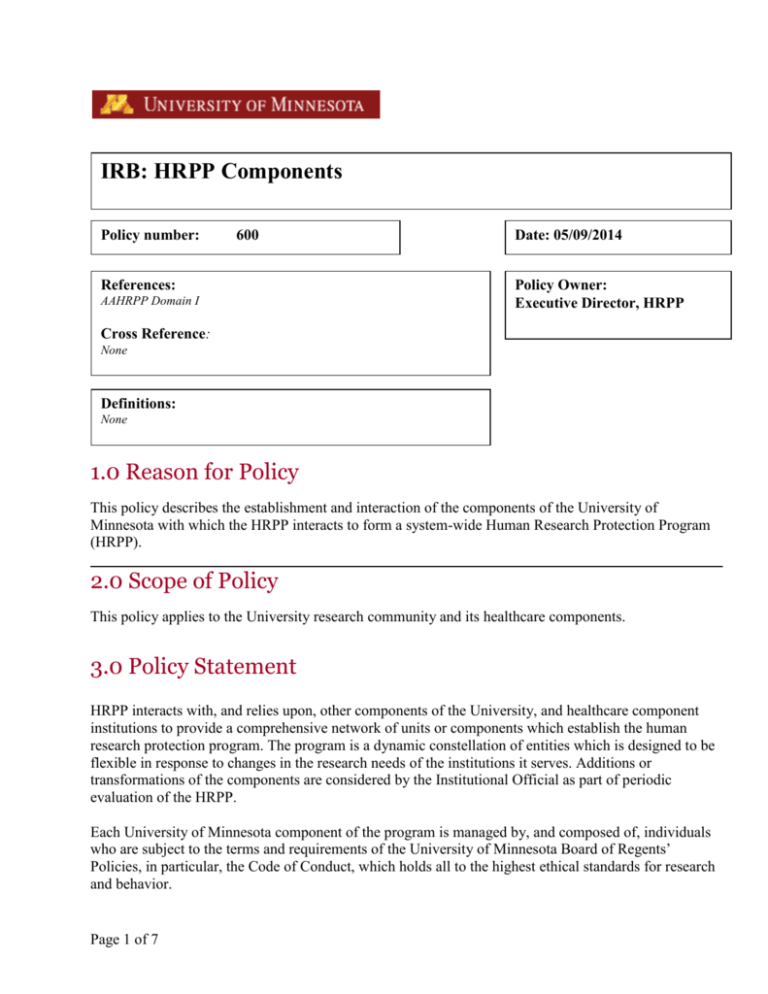
IRB: HRPP Components Policy number: 600 References: AAHRPP Domain I Date: 05/09/2014 Policy Owner: Executive Director, HRPP Cross Reference: None Definitions: None 1.0 Reason for Policy This policy describes the establishment and interaction of the components of the University of Minnesota with which the HRPP interacts to form a system-wide Human Research Protection Program (HRPP). 2.0 Scope of Policy This policy applies to the University research community and its healthcare components. 3.0 Policy Statement HRPP interacts with, and relies upon, other components of the University, and healthcare component institutions to provide a comprehensive network of units or components which establish the human research protection program. The program is a dynamic constellation of entities which is designed to be flexible in response to changes in the research needs of the institutions it serves. Additions or transformations of the components are considered by the Institutional Official as part of periodic evaluation of the HRPP. Each University of Minnesota component of the program is managed by, and composed of, individuals who are subject to the terms and requirements of the University of Minnesota Board of Regents’ Policies, in particular, the Code of Conduct, which holds all to the highest ethical standards for research and behavior. Page 1 of 7 These components include but are not limited to: University of Minnesota (UMN), http://www1.umn.edu/twincities/index.html The University of Minnesota is both the state land-grant university with a strong tradition of education and public service and the state's primary research university with faculty of national and international reputation. The University research portfolio includes human research projects in all areas of study including medical and social and behavioral sciences research. The University’s HRPP program includes well established partnerships with Fairview Health Systems and Gillette Children’s Specialty Healthcare, for whom the University provides IRB review services. UMN departments that provide direct support or interface: Office of the General Counsel (OGC), http://www.ogc.umn.edu/ The OGC functions to meet the varied and highly specialized legal needs of the University of Minnesota. The OGC has designated specific counsel to serve the needs of the research program. Office of Institutional Compliance, http://www.instcomp.umn.edu/about.html The Office of Institutional Compliance serves, safeguards, and promotes ethical practices at the University of Minnesota by: Identifying compliance risks and effective methods to mitigate those risks; Improving delivery of compliance resources; Educating and promoting awareness of ethical and legal standards of conduct through effective programs; and Partnering with responsible University representatives to monitor compliance and to ensure that appropriate and effective corrective actions are taken where non-compliance is detected. Conflict of Interest Committees, (COI), http://www.compliance.umn.edu/conflictHome.htm Consists of three committees--two to manage potential individual conflicts of interest, one to review and manage potential Institutional conflicts. These committees advise HRPP regarding needed changes to research projects based on findings of the committees. These committees formally communicate with HRPP concerning management of COI. The IRB and IBC committees review the suggested language and management plans to determine if subjects have been adequately informed and risks adequately minimized. Department of Audits, http://www1.umn.edu/audit/ Provides independent, objective assurance and advisory services designed to add value and improve the operations of the University of Minnesota. It helps the University accomplish its objectives by bringing a systematic, disciplined approach to evaluate and improve the effectiveness of risk management, control, and governance processes. Office of the Vice President for Research (OVPR), http://www.research.umn.edu/ The Office of the Vice President for Research (OVPR) oversees all aspects of research at the University of Minnesota's five campuses, providing guidance to individual researchers and managing the systemwide research enterprise and is the administrative home of the HRPP. Human Research Protection Programs (HRPP), http://www.research.umn.edu/subjects Page 2 of 7 HRPP provides administrative support to committees reviewing projects involving human subjects, recombinant DNA, infectious agents, and biologically derived toxins. HRPP also supports researchers during their application process and throughout their active projects. Institutional Review Board (IRB), http://www.research.umn.edu/irb/ The IRB reviews research projects which involve human subjects to ensure that two broad standards are upheld: first, that subjects are not placed at undue risk and second, that they give un-coerced, informed consent to their participation. IRB staff support all regulatory requirements for research review and records management, including post approval review for quality assurance. The IRB at the University of Minnesota is the IRB charged with reviewing responsibilities for research conducted in the following areas: Minneapolis, St. Paul, Duluth, Morris, & Crookston campuses, including Research and Outreach Centers, Fairview Health Systems and Gillette Children's Specialty Hospital. Institutional Bio-safety Committee (IBC), http://www.ibc.umn.edu The (IBC) consists of faculty, staff, and community representatives and is charged under Federal Regulations, NIH Guidelines and Regents' Policy with the oversight of all teaching and research activities involving: Recombinant DNA, Synthetic Nucleic Acid Molecules, Artificial Gene Transfer, Infectious agents (bacteria, viruses, protozoans, fungi, etc.), Biologically Derived Toxins. This also includes use of biological materials at sites removed from the University of Minnesota by University faculty, staff, researchers, and non-university staff researchers under grants and contracts to the University. Post-Approval Review (PAR), http://www.research.umn.edu/irb/par.html The PAR component of HRPP is designed to enhance the oversight of approved research involving human subjects and provide a mechanism for assuring the quality of our human subjects research. HRPP will utilize post approval reviews to direct its quality improvement and educational initiatives. IRB staff members are developing mechanisms and methods to assist researchers in meeting the continuous review requirements set by the IRB. These will include researcher self-assessment tools, on-site interviews, research records review, and other collaborative activities to measure and improve the quality, effectiveness, and efficiency of human subjects research approved by the IRB. Scientific Assessment, http://www.research.umn.edu/irb/guidance/scientificreview.html#.U25xsFdYrgg Scientific assessment of greater than minimal risk biomedical research is required. HRPP facilitates one option for securing scientific assessment of new biomedical research proposals. This HRPP assessment may be used to fulfill the scientific review requirement when submitting applications for full committee medical reviews to the IRB. Page 3 of 7 Sponsored Projects Administration (SPA), http://www.ospa.umn.edu/aboutspa.html SPA is the University of Minnesota system-wide office authorized to submit research proposals and receive awards from external sources on behalf of the Board of Regents of the University of Minnesota. SPA is also the fiduciary for the U on grant-related matters. Research Education and Oversight (REO), http://research.umn.edu/reo/#.U25zh1dYrgg The University of Minnesota’s Research Education and Oversight (REO) program facilitates and promotes efficient oversight and risk mitigation within a complex regulatory environment. Education The University of Minnesota and its faculty, students and staff share a commitment to the responsible and ethical conduct of research and scholarship. In support of this commitment, the university maintains a curriculum of instructional materials and workshops. To be eligible to serve as a principal investigator (PI) on a sponsored project, University of Minnesota researchers must complete the responsible conduct of research (RCR) core curriculum. They must also complete additional instruction in specific topics. Oversight The Research, Education and Oversight program staff provide institutional expertise in the analysis, reporting, management and resolution of financial compliance issues. REO also reviews processes related to the use of humans and animals in research. This function represents a basic principle of the University of Minnesota’s sponsored projects oversight model: “Oversight is always separate from the operating unit that makes the decisions.” See the following pages for accurate and current information on federal, state and institutional research oversight and compliance guidelines. Council of Research Associate Deans (CRAD), http://www.research.umn.edu/crad/ The Council serves an advisory role to the Vice President for Research (VPR). Members assist the VPR to formulate university wide policies and systems, promote faculty productivity, and advance strategic goals. As advisory, the Council can present recommendations or preference for particular action, but these are not binding on the VPR. Academic Health Center (AHC), http://www.health.umn.edu/ The AHC comprises six schools and colleges of medicine, public health, nursing, dentistry, pharmacy, and veterinary medicine as well as allied health programs. Interdisciplinary efforts include the Center for Spirituality and Healing, the Center for Bioethics, the Cancer Center, the Center for Infectious Disease Page 4 of 7 Research & Policy, the Center for Animal Health & Food Safety, the Center for Drug Design, and the Biomedical Genomics Center. Center for Bioethics http://www.bioethics.umn.edu/ The mission of the Center is to advance and disseminate knowledge concerning ethical issues in health care and the life sciences. The Center carries out this mission by conducting original interdisciplinary research, offering educational programs and courses, fostering public discussion and debate through community outreach activities, and assisting in the formulation of public policy. The Center provides education in bioethics for University students, faculty, and staff; professionals in health care and related fields; and interested members of the general public. Clinical and Translational Science Institute (CTSI), http://www.ctsi.umn.edu/ The Clinical and Translational Science Institute offers a single point of contact at the University of Minnesota for clinical and translational research resources. Clinical Translational Research Services CTSI's Clinical Translational Research Services (CTRS) team provides comprehensive support for studies across the spectrum of clinical and translational research. CTRS provides assistance with: study planning and design, identifying funding opportunities, budget development, protocol development, regulatory guidance and support, recruitment, staffing and implementation, data collection and management, statistical analysis, and closeout. The CTRS also provides a complimentary education and assistance resource for faculty researchers who are involved in research that requires an investigator held IND or IDE. Health Information Privacy and Compliance Office, http://www.ahc.umn.edu/privacy/home.html The Health Information Privacy and Compliance Office is responsible for the development, implementation, and oversight of policies, procedures, and training to ensure institutional compliance with all of the Health Insurance Portability and Accountability Act (HIPAA) privacy, security, and administrative simplification standards. Healthcare Components: Fairview Health Systems, http://www.fairview.org/Research/ Fairview Research Administration is the first point of contact for research occurring within Fairview Health Services. The office serves Fairview researchers, employees and community physicians, and also works in partnership with the Academic Health Center at the University of Minnesota to further research and education efforts within the community and beyond. Gillette Children’s Specialty Healthcare, http://www.gillettechildrens.org/ Gillette Children's Specialty Healthcare has a long and rich tradition of conducting nationally recognized research. Members of the staff have been leading contributors to progress in the Page 5 of 7 treatment of children and young adults with disabilities. Major areas of interest include cerebral palsy, spinal cord injury, brain injury, spinal disorders and gait analysis. Committees: IRB Consultative Committees: The Vice President for Research/Institutional Official (IO) may establish ad hoc committees for IRB related activity. When requested the committees may provide feedback and input on processes, education and mechanisms for review of human subjects research projects with the intent to improve communication with the research community. These committees are convened at the discretion of the IO. All University Radiation Committee (AURPAC), http://www.dehs.umn.edu/rad_committees_hus.htm The AURPAC convenes as needed to review radiation use in research protocols and provide expert opinion to the IRB on safety and information concerning radiation exposure and risks. Cancer Protocol Review Committee (CPRC), http://www.cancer.umn.edu/clinicaltrials/cancer-protocol-review-commitee/ The CPRC conducts scientific review of all newly proposed and ongoing institutional clinical cancer research protocols, monitors all clinical cancer research protocols for sufficient progress on an annual basis, and terminates cancer protocols if found deficient in accrual or scientific progress. Center for Magnetic Resonance Research (CMRR) Safety Committee, http://www.cmrr.umn.edu/tour/index.shtml The Center for Magnetic Resonance Research (CMRR) is an interdepartmental and interdisciplinary research laboratory that provides state-of-the-art instrumentation, expertise, and infrastructure to carry out biomedical research utilizing the unique capabilities provided by high field MRI and MRS methodology. The CMRR Safety Committee reviews protocols for human subjects research proposing to use Magnetic Resonance (MR) scanners housed at the CMRR, prior to their submission to the IRB. Outreach and Communications: Academic Health Center Communications (AHC), http://hub.ahc.umn.edu/communications Office of the Vice President for Research: Communications Team, http://www.research.umn.edu/news The Office of the Vice President for Research (OVPR) actively communicates about the research mission of the University. The OVPR disseminates information about the administration of research at the University, publicizes the quality research being performed at the University, and reports on research-related activities at the University to both internal and external audiences. The OVPR is also a resource for both internal and external constituencies about research-related matters. 4.0 Required approvals for this document Page 6 of 7 Title Executive Director, HRPP 5.0 Revision History Revision 05/09/14 01/04/11 11/09/09 07/27/09 07/06/09 06/09/09 05/22/09 05/10/07 09/26/06 Reason for change Update links and programs Reorganization of post approval functions Update AAHRPP references Revision Revision Revision New format Revision Policy Development Date of release 09/02/14 01/04/11 11/09/09 To obtain a copy of a historical policy, e-mail IRB at irb@umn.edu or call 612-626-5654 Page 7 of 7
